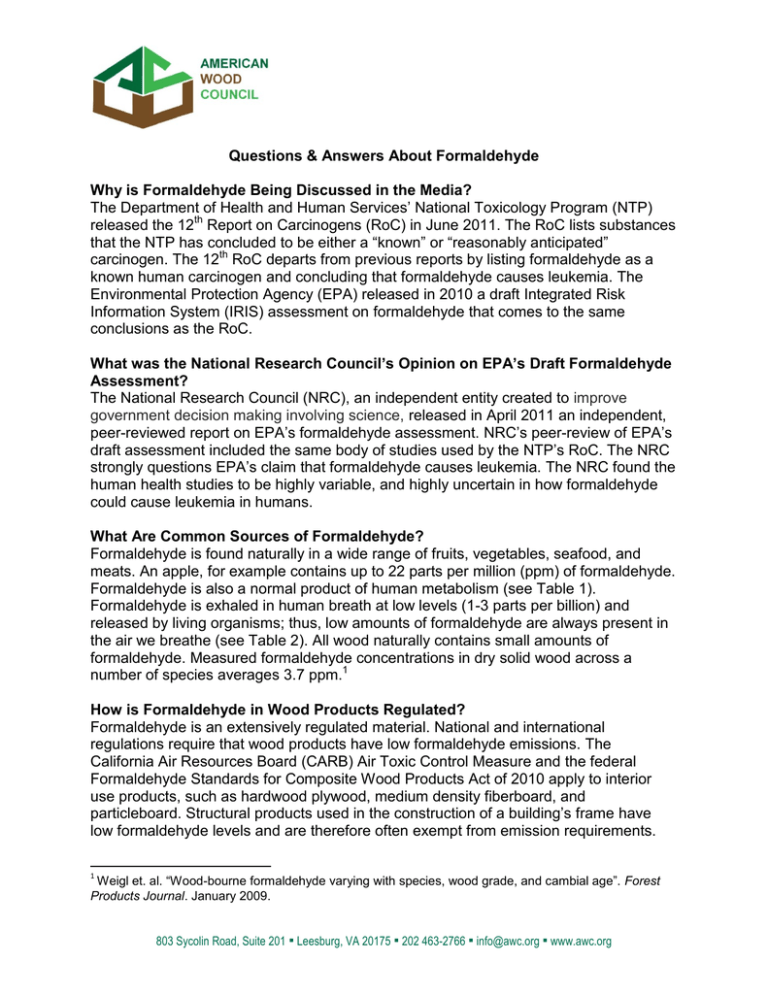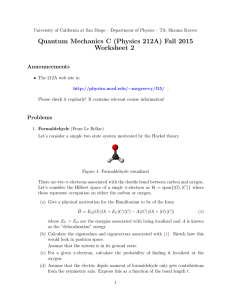The Department of Health and Human Services’ National Toxicology Program... released the 12
advertisement

Questions & Answers About Formaldehyde Why is Formaldehyde Being Discussed in the Media? The Department of Health and Human Services’ National Toxicology Program (NTP) released the 12th Report on Carcinogens (RoC) in June 2011. The RoC lists substances that the NTP has concluded to be either a “known” or “reasonably anticipated” carcinogen. The 12th RoC departs from previous reports by listing formaldehyde as a known human carcinogen and concluding that formaldehyde causes leukemia. The Environmental Protection Agency (EPA) released in 2010 a draft Integrated Risk Information System (IRIS) assessment on formaldehyde that comes to the same conclusions as the RoC. What was the National Research Council’s Opinion on EPA’s Draft Formaldehyde Assessment? The National Research Council (NRC), an independent entity created to improve government decision making involving science, released in April 2011 an independent, peer-reviewed report on EPA’s formaldehyde assessment. NRC’s peer-review of EPA’s draft assessment included the same body of studies used by the NTP’s RoC. The NRC strongly questions EPA’s claim that formaldehyde causes leukemia. The NRC found the human health studies to be highly variable, and highly uncertain in how formaldehyde could cause leukemia in humans. What Are Common Sources of Formaldehyde? Formaldehyde is found naturally in a wide range of fruits, vegetables, seafood, and meats. An apple, for example contains up to 22 parts per million (ppm) of formaldehyde. Formaldehyde is also a normal product of human metabolism (see Table 1). Formaldehyde is exhaled in human breath at low levels (1-3 parts per billion) and released by living organisms; thus, low amounts of formaldehyde are always present in the air we breathe (see Table 2). All wood naturally contains small amounts of formaldehyde. Measured formaldehyde concentrations in dry solid wood across a number of species averages 3.7 ppm.1 How is Formaldehyde in Wood Products Regulated? Formaldehyde is an extensively regulated material. National and international regulations require that wood products have low formaldehyde emissions. The California Air Resources Board (CARB) Air Toxic Control Measure and the federal Formaldehyde Standards for Composite Wood Products Act of 2010 apply to interior use products, such as hardwood plywood, medium density fiberboard, and particleboard. Structural products used in the construction of a building’s frame have low formaldehyde levels and are therefore often exempt from emission requirements. 1 Weigl et. al. “Wood-bourne formaldehyde varying with species, wood grade, and cambial age”. Forest Products Journal. January 2009. 803 Sycolin Road, Suite 201 ▪ Leesburg, VA 20175 ▪ 202 463-2766 ▪ info@awc.org ▪ www.awc.org Mandatory government regulations set and use published standards to protect human health and the environment. These requirements for formaldehyde allow for the safe production, storage, handling and use of this important building block chemical. Based on the extensive amount of data, there is widespread recognition that when formaldehyde is handled and used properly in accordance with government and industry regulations, standards and guidelines, formaldehyde is safe for its intended uses, and consumers and workers are appropriately protected. The U.S. wood products industry supports and complies with these established standards. Three agencies – U.S. EPA, Consumer Product Safety Commission (CPSC), and U.S. Department of Housing and Urban Development (HUD) – have addressed indoor air exposure to formaldehyde. Since the forest products industry developed low-emitting resins and voluntarily adopted product emission standards such as CARB and American National Standards Institute standards for particleboard, medium-density fiberboard and hardwood plywood, indoor formaldehyde emissions have declined significantly. CPSC determined that any further action was superfluous given the voluntary actions and low measured levels of formaldehyde. Table 1 Source/Description Apple Pork Cow’s Milk Fish (salt water) Approximate Formaldehyde Content parts per million (ppm) 22 ppm 20 ppm Up to 3.3 ppm 20 ppm Endnote Note 8 Note 8 Note 8 Note 8 Table 2 Source/Description Painting a 12 ft x 12 ft x 9 ft room Wallpapering a 12 ft x 12 ft x 9 ft room Walk-in closet with 20 permanent press shirts (washed) Broil fish using a gas or electric range Gas Range in Self-Clean mode Electric Range in Self-Clean modei One Cigarette in small room Human Breath Residential Air (mobile homes) Residential Air (conventional homes) Urban Air Rural Air Expected Formaldehyde Exposure, parts per billion (ppb) 968 2051 231 105 337 183 49 Around 2 77 17 5 - 100 0.8 - 5 Endnote Note 1 Note 1 Note 2 Note 3 Note 3 Note 3 Note 4 Note 5 Note 6 Note 7 – – Note 1: Calculated from data taken from the Batelle report for the California Air Resources Board, Determination of Formaldehyde & Diisocynate Emission from Residential Indoor Sources, Contract No. 93-9315, Final Report 1996. Questions & Answers About Formaldehyde AWC Page -2- Note 2: This example is calculated from data for washed permanent press shirts from the Battelle report for the California Air Resources Board, Determination of Formaldehyde & Diisocynate Emission from Residential Indoor Sources, Contract No. 93-9315, Final Report 1996. Note 3: Indoor Air Quality Residential Cooking Exposures Final Report, Prepared for The California Air Resources Board, CARB Contract Number 97-330, Prepared by Ray Fortmann, Peter Kariher, and Russ Clayton, ARCADIS, Geraghty & Miller, Inc, November 30, 2001. Note 4: Reference taken from the International Programme on Chemical Safety, Environmental Health Criteria 89 published under the joint sponsorship of The United Nations Environment Programme, The International Labour Organization, The World Health Organization, Geneva, 1989. Note 5: Mass spectrometric profile of exhaled breath – Field study by PTR-MS, Berthold Moser, Florian Bodrogi, Guenther Eibl, Matthias Lechner, Josef Rieder, Philipp Lirk, 2004. Note 6: Final Report on Formaldehyde Levels in FEMA-Supplied Travel Trailers, Park Models and Mobile Homes from the Centers for Disease Control and Prevention, December 2010. The 77 ppb is the geometric mean level of formaldehyde in travel trailers, park models and mobile homes. Note 7: Weisel et al. 2005. Relationships of indoor, outdoor, and personal air (RIOPA). Part I. Collection methods and descriptive analyses. Research Report (Health Effects Institute) (130 Pt 1):1–107; discussion 109–27. Note 8: International Programme on Chemical Safety, Environmental Health Criteria: Formaldehyde, World Health Organization, 1989. Questions & Answers About Formaldehyde AWC Page -3-




